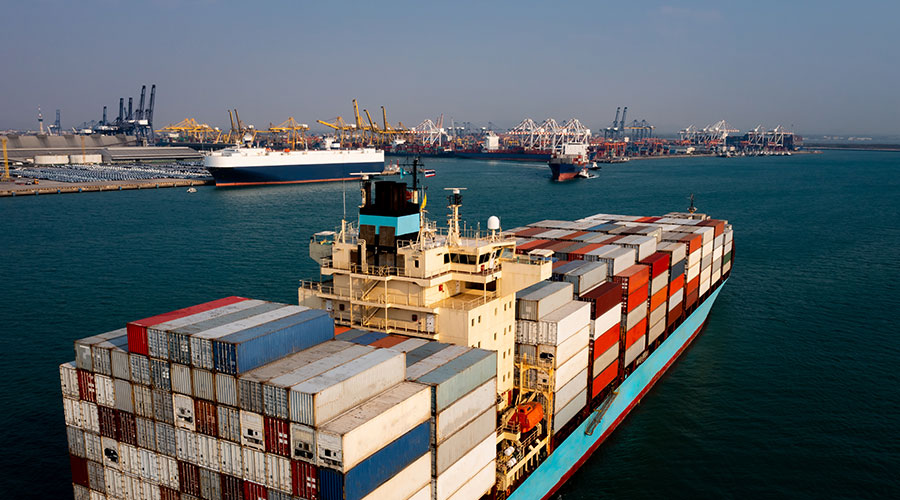

Freight rates continue to rise, and the African routes are fully booked
This week, the spot price of container freight on the Trans-Pacific route rose sharply as the Sino-US trade war was suspended for 90 days, leading to a sudden increase in market demand. The latest SCFI freight rate index rose by 9.97% on a weekly basis. Due to the reduction in tariffs, freight rates on the North American route increased. The freight rates per FEU from the Far East to the West Coast of the United States and from the East Coast of the United States rose by 31.7% and 22% respectively, and the subsequent increase may be even greater.
A freight forwarder in Qingdao said that the freight rate from the Far East to Los Angeles on the US route has doubled compared to last week and changes every day. Many ships that originally operated on other routes have started to switch to the US route. As a result, the freight rates on other routes such as Mexico have also risen. On the 16th, a salesperson from a freight forwarder company in Shanghai disclosed that there was also a situation of full capacity on routes to the Middle East and Africa. For a business they were handling in the Middle East, they failed to secure a seat even after making a reservation 10 days in advance, and the freight rate even increased by 10% to 20%. Besides, just now, he also received a notice from MSC that there are no special offer cabins on the Eastern route and the FAK rate will be implemented. These situations are all chain reactions triggered by the inflation and price hikes on the US route.
From the perspective of the freight rate index, the latest Shanghai Container Export (SCFI) freight rate Index (released on the 16th) rose by 134.22 points to 1,479.39 points, with a weekly increase of 9.97%. Among them, the freight rates on the North American route began to rise due to the lifting effect triggered by the reduction of tariffs. Specifically, the freight rate per FEU (40-foot container) from the Far East to the West Coast of the United States reached $3,091, a significant increase of $744 compared to the previous period, representing a growth rate of 31.7%. The freight rate per FEU from the Far East to the eastern United States reached $4,069, an increase of $734 compared to the previous period, representing a growth rate of 22%. Moreover, this is only the beginning of the increase in freight rates, and the future increase is expected to be even greater.
The World Containerized Freight Index (WCI) released by Drewry this week also confirms the upward trend in freight rates. Data shows that the freight rate for the Shanghai-Los Angeles route has risen by 16% compared to last week to $3,136 per 40 feet. The freight rate for the Shanghai-New York route has risen even more, increasing by 19% compared to the previous week to $4,350 per 40 feet.
The significant increase in freight rates this time is mainly attributed to the sudden rise in order volume. Hapag-lloyd's CEO Rolf Habben Jensen disclosed at the company's first-quarter earnings call on Wednesday that the order volume on Monday and Tuesday increased by 50% compared with the previous week.
In addition, the previously announced series of GRI hikes have also played a promoting role. Starting from May 15th, the rate for each 40-foot container has been raised by $1,000 to $3,000, and these rates have remained unchanged. If demand remains stable as the 90-day period progresses, the further GRI set on June 1st (also within the range of $1,000 to $3,000, depending on the carrier) will also continue to be implemented.
Second, in terms of capacity, shipping companies are also actively making adjustments. Gemini Lines said it is expanding the size of vessels on its Trans-Pacific routes to meet the reinvigorating market demand. Maersk said on the 16th that customers have been granted a 90-day tariff preference period and the company is striving to help customers make the most of this opportunity. Since the agreement was announced, Maersk's bookings for the Trans-Pacific route have increased. After reducing its capacity in April, it has once again increased its capacity.
Furthermore, Premier Alliance announced on the 16th that it will officially launch its PS5 Trans-Pacific route, which has been postponed due to the recent decline in booking volume. The main carrier ONE said that the route will make its maiden voyage on June 5th. At that time, the 6,500 TEU YM Mobility will set sail from Qingdao, with the port call sequence being Qingdao - Ningbo - Changtan - Auckland - Kobe - Qingdao. It is expected that seven vessels will be deployed.
Iii. Regarding the increase in freight rates, various companies have successively proposed relevant measures:
The price increase starting from May 15th or 21st and 22nd ranges from 500 to 1,000 US dollars per large container (40-foot container).
The price increase on June 1st ranges from 1,500 to 3,000 US dollars, depending on the carrier.
On June 15th, most companies have not yet announced the increase. Among the companies that have confirmed the increase, Mediterranean Shipping Company (MSC), CMA CGM and Sunro (SML) are all scheduled to increase by a significant $4,000.
On June 1st, Yangming, Japan Ocean Network Shipping (ONE), HMM and Haha-Lloyd all scheduled a price increase of $2,000. Zim will raise its prices by $800 to $1,000 depending on the destination, and by $2,500 for non-China regions. Maersk raised its prices by $2,000 in non-Chinese regions on June 1st and by $2,000 in Chinese regions on June 9th. MSC will increase its price by $1,000 or $2,000 depending on the location on June 1st. Evergreen Marine Corporation is scheduled to announce the increase on the 17th.
If all the currently determined three-stage increase rates are achieved, the freight rate per large container on the US West Coast route will be between 7,000 and 8,000 US dollars. However, it is expected that by then, most of the flights originally diverted from the US route will have resumed operations, and there may even be additional flights. The chance of a real increase of 4,000 US dollars may not be high.
In addition, the freight rates on the Far East to Europe route have been oversupplied due to the previous excessive deployment of ships on the North American route. However, industry insiders believe that this low freight rate situation will not last long. As many ships return to the North American route in June, the supply and demand relationship of capacity on the Far East to Europe route will change rapidly, and freight rates will rise.
The actual situation also confirms this view. Shipping giants such as Mediterranean Shipping Company (MSC), CMA CGM, and Hapag-Lloyd have successively issued notices, announcing an increase in FAK rates from the Far East to Europe and the Mediterranean region starting from June 1st. Hapag-lloyd set the freight rate from Asia to Northern Europe at $3,300 per 40 feet and the freight rate from the Western Mediterranean at $4,400 per 40 feet. Cma CGM announced that the FAK rate from Asia to Northern Europe is $3,100 per 40 feet. Mediterranean Shipping Company announced that the FAK rate to Northern Europe is $3,200 per 40 feet, and the rate to Mediterranean ports is $5,000 per 40 feet.
SCFI freight rate
The freight rate from Shanghai to Europe is 1,154 US dollars per TEU, down 7 US dollars, with a weekly decline of 0.6%.
The freight rate from Shanghai to the Mediterranean is $2,082 per TEU, down $7, with a weekly decline of 0.3%.
The freight rate from Shanghai to the West Coast of the United States is 3,091 US dollars per FEU, with a weekly increase of 744 US dollars, representing a weekly growth of 31.7.
The freight rate from Shanghai to the East Coast of the United States is $4,069 per FEU, a significant increase of $734, representing a 22% rise.
In terms of the near-sea route, the price per TEU from the Far East to Southeast Asia rose by 4 US dollars compared with the previous period, with an increase of 0.93%. The price per TEU from the Far East to Kansai, Japan, dropped by 1 US dollar compared to the previous period. The price per TEU from the Far East to Kansai, Japan remained the same as the previous period. The price per TEU from the Far East to South Korea dropped by 4 US dollars.

A freight forwarder in Qingdao said that the freight rate from the Far East to Los Angeles on the US route has doubled compared to last week and changes every day. Many ships that originally operated on other routes have started to switch to the US route. As a result, the freight rates on other routes such as Mexico have also risen. On the 16th, a salesperson from a freight forwarder company in Shanghai disclosed that there was also a situation of full capacity on routes to the Middle East and Africa. For a business they were handling in the Middle East, they failed to secure a seat even after making a reservation 10 days in advance, and the freight rate even increased by 10% to 20%. Besides, just now, he also received a notice from MSC that there are no special offer cabins on the Eastern route and the FAK rate will be implemented. These situations are all chain reactions triggered by the inflation and price hikes on the US route.
From the perspective of the freight rate index, the latest Shanghai Container Export (SCFI) freight rate Index (released on the 16th) rose by 134.22 points to 1,479.39 points, with a weekly increase of 9.97%. Among them, the freight rates on the North American route began to rise due to the lifting effect triggered by the reduction of tariffs. Specifically, the freight rate per FEU (40-foot container) from the Far East to the West Coast of the United States reached $3,091, a significant increase of $744 compared to the previous period, representing a growth rate of 31.7%. The freight rate per FEU from the Far East to the eastern United States reached $4,069, an increase of $734 compared to the previous period, representing a growth rate of 22%. Moreover, this is only the beginning of the increase in freight rates, and the future increase is expected to be even greater.
The World Containerized Freight Index (WCI) released by Drewry this week also confirms the upward trend in freight rates. Data shows that the freight rate for the Shanghai-Los Angeles route has risen by 16% compared to last week to $3,136 per 40 feet. The freight rate for the Shanghai-New York route has risen even more, increasing by 19% compared to the previous week to $4,350 per 40 feet.
The significant increase in freight rates this time is mainly attributed to the sudden rise in order volume. Hapag-lloyd's CEO Rolf Habben Jensen disclosed at the company's first-quarter earnings call on Wednesday that the order volume on Monday and Tuesday increased by 50% compared with the previous week.
In addition, the previously announced series of GRI hikes have also played a promoting role. Starting from May 15th, the rate for each 40-foot container has been raised by $1,000 to $3,000, and these rates have remained unchanged. If demand remains stable as the 90-day period progresses, the further GRI set on June 1st (also within the range of $1,000 to $3,000, depending on the carrier) will also continue to be implemented.
Second, in terms of capacity, shipping companies are also actively making adjustments. Gemini Lines said it is expanding the size of vessels on its Trans-Pacific routes to meet the reinvigorating market demand. Maersk said on the 16th that customers have been granted a 90-day tariff preference period and the company is striving to help customers make the most of this opportunity. Since the agreement was announced, Maersk's bookings for the Trans-Pacific route have increased. After reducing its capacity in April, it has once again increased its capacity.
Furthermore, Premier Alliance announced on the 16th that it will officially launch its PS5 Trans-Pacific route, which has been postponed due to the recent decline in booking volume. The main carrier ONE said that the route will make its maiden voyage on June 5th. At that time, the 6,500 TEU YM Mobility will set sail from Qingdao, with the port call sequence being Qingdao - Ningbo - Changtan - Auckland - Kobe - Qingdao. It is expected that seven vessels will be deployed.
Iii. Regarding the increase in freight rates, various companies have successively proposed relevant measures:
The price increase starting from May 15th or 21st and 22nd ranges from 500 to 1,000 US dollars per large container (40-foot container).
The price increase on June 1st ranges from 1,500 to 3,000 US dollars, depending on the carrier.
On June 15th, most companies have not yet announced the increase. Among the companies that have confirmed the increase, Mediterranean Shipping Company (MSC), CMA CGM and Sunro (SML) are all scheduled to increase by a significant $4,000.
On June 1st, Yangming, Japan Ocean Network Shipping (ONE), HMM and Haha-Lloyd all scheduled a price increase of $2,000. Zim will raise its prices by $800 to $1,000 depending on the destination, and by $2,500 for non-China regions. Maersk raised its prices by $2,000 in non-Chinese regions on June 1st and by $2,000 in Chinese regions on June 9th. MSC will increase its price by $1,000 or $2,000 depending on the location on June 1st. Evergreen Marine Corporation is scheduled to announce the increase on the 17th.
If all the currently determined three-stage increase rates are achieved, the freight rate per large container on the US West Coast route will be between 7,000 and 8,000 US dollars. However, it is expected that by then, most of the flights originally diverted from the US route will have resumed operations, and there may even be additional flights. The chance of a real increase of 4,000 US dollars may not be high.
In addition, the freight rates on the Far East to Europe route have been oversupplied due to the previous excessive deployment of ships on the North American route. However, industry insiders believe that this low freight rate situation will not last long. As many ships return to the North American route in June, the supply and demand relationship of capacity on the Far East to Europe route will change rapidly, and freight rates will rise.
The actual situation also confirms this view. Shipping giants such as Mediterranean Shipping Company (MSC), CMA CGM, and Hapag-Lloyd have successively issued notices, announcing an increase in FAK rates from the Far East to Europe and the Mediterranean region starting from June 1st. Hapag-lloyd set the freight rate from Asia to Northern Europe at $3,300 per 40 feet and the freight rate from the Western Mediterranean at $4,400 per 40 feet. Cma CGM announced that the FAK rate from Asia to Northern Europe is $3,100 per 40 feet. Mediterranean Shipping Company announced that the FAK rate to Northern Europe is $3,200 per 40 feet, and the rate to Mediterranean ports is $5,000 per 40 feet.
SCFI freight rate
The freight rate from Shanghai to Europe is 1,154 US dollars per TEU, down 7 US dollars, with a weekly decline of 0.6%.
The freight rate from Shanghai to the Mediterranean is $2,082 per TEU, down $7, with a weekly decline of 0.3%.
The freight rate from Shanghai to the West Coast of the United States is 3,091 US dollars per FEU, with a weekly increase of 744 US dollars, representing a weekly growth of 31.7.
The freight rate from Shanghai to the East Coast of the United States is $4,069 per FEU, a significant increase of $734, representing a 22% rise.
In terms of the near-sea route, the price per TEU from the Far East to Southeast Asia rose by 4 US dollars compared with the previous period, with an increase of 0.93%. The price per TEU from the Far East to Kansai, Japan, dropped by 1 US dollar compared to the previous period. The price per TEU from the Far East to Kansai, Japan remained the same as the previous period. The price per TEU from the Far East to South Korea dropped by 4 US dollars.





